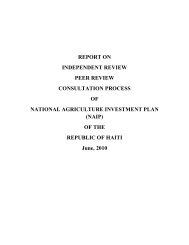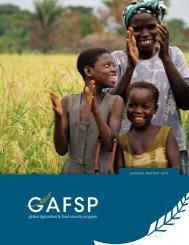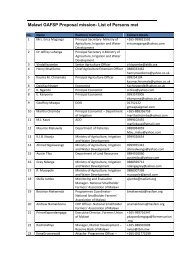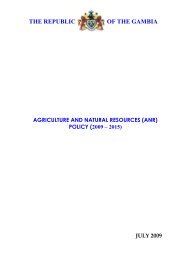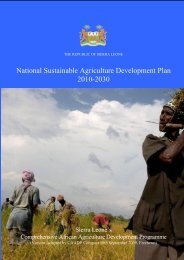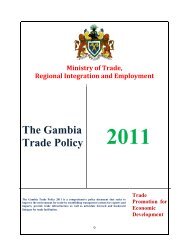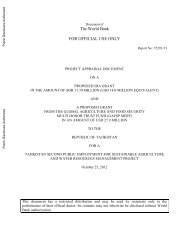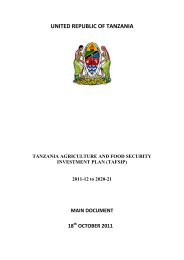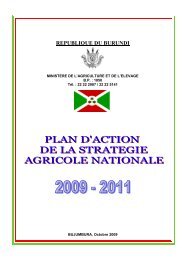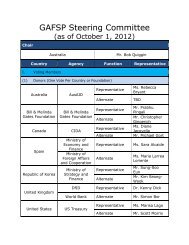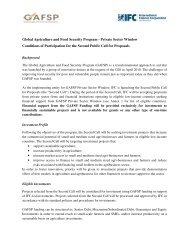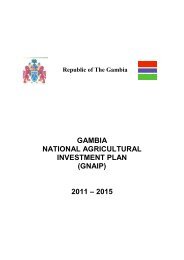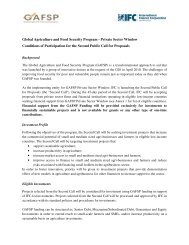Haiti: Poverty Reduction Strategy Paper; IMF Country Report 08/115 ...
Haiti: Poverty Reduction Strategy Paper; IMF Country Report 08/115 ...
Haiti: Poverty Reduction Strategy Paper; IMF Country Report 08/115 ...
You also want an ePaper? Increase the reach of your titles
YUMPU automatically turns print PDFs into web optimized ePapers that Google loves.
EXECUTIVE SUMMARY<br />
Over the past twenty years, <strong>Haiti</strong> has undergone profound change that has affected all aspects of<br />
national life, particularly in the political, economic, social, and environmental spheres.<br />
The political stability restored in 2006, the successful establishment of a macroeconomic<br />
framework, the reduction in insecurity, and modest but sustained economic growth over the past<br />
four years represent significant strides. However, they are not enough to cope with the myriad<br />
challenges facing the country. The Growth and <strong>Poverty</strong> <strong>Reduction</strong> <strong>Strategy</strong> <strong>Paper</strong> (DSNCRP) has<br />
been drafted with a view to tackling these challenges and providing satisfactory responses to the<br />
aspirations of the <strong>Haiti</strong>an people.<br />
The paper is broken down into five parts. The first provides an assessment of poverty and<br />
inequality on the basis of the data gathered from the most recent surveys. The second outlines the<br />
vision of state and non-state actors as well as the challenges to be met by 2015. The third<br />
essentially summarizes the major areas of work decided upon by the Government of <strong>Haiti</strong> at the<br />
July 25, 2006 International Conference, which have been reorganized into three pillars: growth<br />
vectors, human development, and democratic governance supported by targeted and cross-cutting<br />
strategic areas of intervention. The fourth pertains to the macroeconomic framework and<br />
policies. Lastly, the fifth covers the financing, implementation, and monitoring of the DSNCRP.<br />
Overview of <strong>Poverty</strong> in <strong>Haiti</strong><br />
Data on poverty and inequality in <strong>Haiti</strong> show that in 2001, 56 percent of the <strong>Haiti</strong>an population<br />
(4.4 million persons of a total population of 8.1 million) lived below the extreme poverty line of<br />
US$1 PPP per person, per day. It was estimated that for every ten persons, 7.6 are considered<br />
poor; that is, they do not receive US$2 PPP per person, per day, and that 40 percent of the poorest<br />
population groups have access to only 5.9 percent of total income, while the most affluent 20<br />
percent control 68 percent of this income. Consequently, 80 percent of the population controls a<br />
mere 32 percent of income, while it is projected that 2 percent of the wealthiest segment controls<br />
26 percent of total income.<br />
<strong>Haiti</strong> was reported to have regressed on the human development scale, falling from position 146<br />
in 2000 to 153 in 2005. The IHSI, in conjunction with the Latin American and Caribbean<br />
Demographic Center [Centre Latino Américain de Démographie CELADE] and the UNFPA,<br />
estimated life expectancy at birth to be 58.1 percent (2000-2005), based on data taken from the<br />
2003 survey.<br />
Other indices, such as the gradual increase in deforestation, infant malnutrition, and the annual<br />
average decline in real per capita income and average consumption, point to a deterioration in<br />
living conditions.<br />
The Republic of <strong>Haiti</strong>, faced with the dire consequences of poverty and documented social<br />
inequalities, has pledged to face the challenge by seeking, through a participatory process that<br />
includes all the different population groups, the most effective national strategy for achieving<br />
sustainable growth and a substantial reduction in poverty.<br />
The Participatory Process<br />
The participatory approach adopted for the drafting of the DSNCRP ensured broad–based<br />
stakeholder involvement. All activities took place in two phases. The first, which was called<br />
awareness-building/consultation, took place at the departmental and sectoral levels. The<br />
consultation process included more than 2,000 persons throughout the country. Officials elected<br />
8



